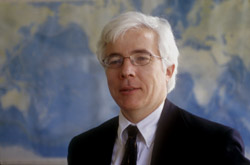
|
| John A. Tarduno, professor of physics and astronomy and chair of the Department of Earth and Environmental Sciences (PHOTO CREDIT: University of Rochester) |
|
High-resolution photo for download (please include photo credit) |
Geophysicist John A. Tarduno, professor of physics and astronomy and chair of the Department of Earth and Environmental Sciences at the University of Rochester, has been named a 2006 Guggenheim Fellow for his work revealing how the Earth's magnetic field functions, and has changed over the planet's lifetime. The fellowships are awarded to men and women who have demonstrated exceptional capacity for productive scholarship.
Tarduno plans to use the fellowship to travel to South Africa and Swaziland where he will collect rocks from the Archean age, 3.5 billion years ago, when life first began. Since these rocks are some of the oldest on the planet, they hold information on the strength and nature of the magnetic field of the early Earth. After bringing the sample rocks back to Rochester, Tarduno will use a new technique he has developed to study the intensity of the Earth's magnetic field in ancient rocks. The technique uses silicate crystals a just a few millimeters long that are excellent recorders of prehistoric field strength.
Tarduno also will focus on understanding how the magnetic field has shielded the Earth from much of the Sun's harmful radiation over the planet's lifetime. Over the last 150 years, the strength of Earth's magnetic field has weakened measurably, possibly heralding a pole-reversal when compasses would point south instead of north. Tarduno will apply what is known about the present-day decay of the magnetic field and its effect on Earth's magnetic shielding, to the distant past, in order to better understand what effect lesser shielding may have had on developing life.
"This will be an excellent opportunity to explore several key questions concerning the early evolution of Earth's interior—and its relationship to exogenic factors that likely shaped Earth's environment," says Tarduno. "It's an opportunity for which I am truly grateful to the Guggenheim Foundation."
Guggenheim fellows are appointed on the basis of unusually distinguished achievement in the past, and exceptional promise for future accomplishments. The 2006 fellowship winners include 187 artists, scholars, and scientists selected from almost 3,000 applicants for awards totaling $7.5 million.
